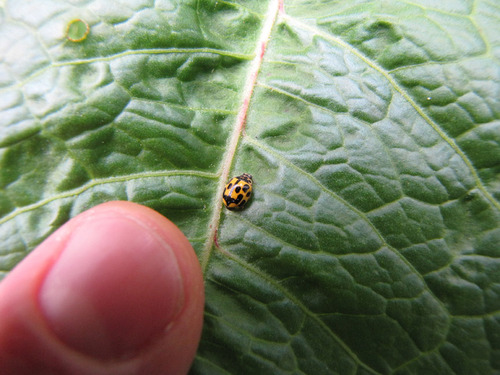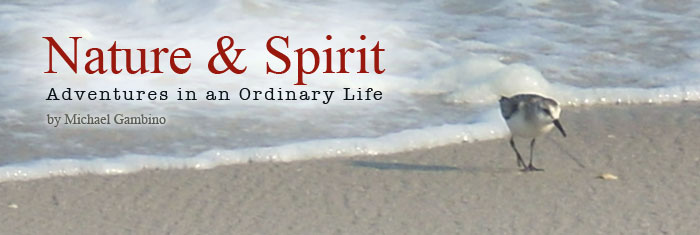Bigger is Better, Except When it's Not
 Sunday, December 12, 2010 at 12:02PM
Sunday, December 12, 2010 at 12:02PM  Multicolored Asian Lady Beetle (Harmonia axyridis). A big name for a tiny creature!There's a reason we don't see 600 pound Chipmunks bolting across the lawn, or encounter amoebas the size of The Blob, or guard our summer evening tranquility from being punctured by mosquitoes cruising around on ten-foot wings: bigger is not always better. For that matter neither is being small or microscopic. Size is important relative to species and their ecological niche. It would not serve the survival of chipmunks as a species to be that large. Could you imagine them as big game animals?
Multicolored Asian Lady Beetle (Harmonia axyridis). A big name for a tiny creature!There's a reason we don't see 600 pound Chipmunks bolting across the lawn, or encounter amoebas the size of The Blob, or guard our summer evening tranquility from being punctured by mosquitoes cruising around on ten-foot wings: bigger is not always better. For that matter neither is being small or microscopic. Size is important relative to species and their ecological niche. It would not serve the survival of chipmunks as a species to be that large. Could you imagine them as big game animals?
When it comes to humans, some people live a very large life full of great adventures and bold achievement; others live a quiet obscure life in their own small niche. One path is not better or worse than the other. Each way has its unique set of challenges and triumphs. Each can make a contribution to the world, be it great or small.
In our society, many people are hypnotized by the rich and famous, or are themselves obsessed with trying to get famous – the internet is full of their attempts. Then there is the proliferation of reality TV shows. There are shows about competitive tow-truck drivers, competitive tornado-chasers, pest exterminators, junk yard bosses, and, for the love of God, "real housewives". It seems people will do anything for their 15-minutes of fame. A microscopic organism swimming in pond water doesn't spend its brief life wishing it was a famously big fish, and a Hippopotamus isn't wallowing in self-loathing while dreaming of being a gazelle someday.
Our society is absolutely addicted to competition. Businesses and governments wield it as a tool to shape the marketplace, the job market, consumer behavior, and elections. It has seeped into every aspect of life to the point that some parents are already sweating their toddler's acceptance into "the best" kindergarten schools that will start their long journey to an Ivy-League University someday.
Just try going to a party without having anything exciting to offer those that inquire: "So, what do you do for a living?" Competitive pressure has its rightful place in the world, but it is not the only or even most important way to live. The person that honks their horn at you the very nano-second that the traffic light turns green is most likely consumed by a toxic impatience induced by an overly competitive culture.
When I was a child, I wanted to be an astronaut, a soldier, a priest, an explorer, and other such bold and prominent professionals. I never became any of those because I was meant to be something else. I was meant to be me – whatever that turned out to be. I may wish things had worked out differently sometimes, but largely I have tried to honor who and where I am in life. That sounds like it should be easy, but it is not. It takes time and commitment to really "know thyself". In our culture, we are aggressively and relentlessly conditioned to be dissatisfied and to always want more. Not coincidentally, this conditioning makes us ideal consumers – the goal of most businesses. In the end, we spend our time and money one way or another trying to have it all.
 Don't let this happen to YOU! (Click to enlarge).
Don't let this happen to YOU! (Click to enlarge).
Perhaps we should deliberately step aside and let the caffeinated, competitive hoards race past us. Sure, we might be left behind, but who has declared that as bad, lazy, or foolish? There are other paths to follow in the world that will lead us just as surely, to a life worth living; a life full of beauty, worthy achievement, and meaningful relationships. As Lily Tomlin once said, "the problem with the rat race is that even if you win the race, you're still a rat."
________________________________________________________
On a somewhat related note:
This video below shows a microscopic animal called a rotifer. They can be found in ponds, streams, and oceans. This one came from a drop of water on some moss and was filmed with a simple digital camera shooting through the eyepiece of the microscope. It's a little tricky to do, but it can be done. Note the cilia hairs moving at high-speed, and the small specks of food moving through the animal's gut. (Thanks to my colleague Taro for finding this critter under the scope.)
I'm guessing that most people have never heard of these animals. Without legions of such tiny, unseen, and unglamorous animals as these, whole ecosystems would be adversely affected. Hey, maybe they have earned a right to their own reality TV show! (If the video won't play, go here to view it: http://www.youtube.com/watch?v=WmzKlWnydng)

Reader Comments (1)
Kudos again, Michael. You are the best!
You know who.